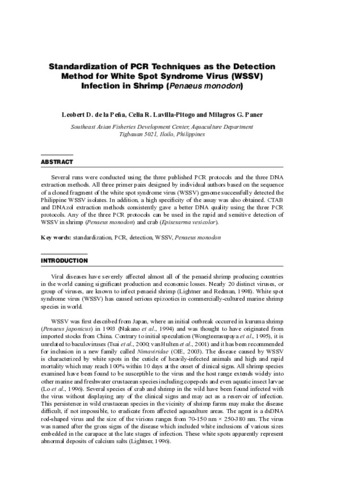Abdominal segment deformity syndrome (asds) and fused body segment deformity (fbsd) in cultured Penaeus indicus
| dc.contributor.author | Santander-Avancena, Sheryll | |
| dc.contributor.author | Estepa, Fe Dolores | |
| dc.contributor.author | Catedral, Demy M. | |
| dc.contributor.author | Faisan, Joseph P., Jr. | |
| dc.contributor.author | de la Peña, Leobert D. | |
| dc.date.accessioned | 2017-01-09T08:47:43Z | |
| dc.date.available | 2017-01-09T08:47:43Z | |
| dc.date.issued | 2017 | |
| dc.identifier.citation | Santander-Avanceña, S., Parado-Estepa, F. D., Catedral, D. M., Faisan, J., & de la Peña, L. D. (2017). Abdominal segment deformity syndrome (asds) and fused body segment deformity (fbsd) in cultured Penaeus indicus. Aquaculture, 466, 20-25. | en |
| dc.identifier.issn | 0044-8486 | |
| dc.identifier.uri | http://hdl.handle.net/10862/3100 | |
| dc.description.abstract | The abdominal segment deformity disease (ASDD) is a new shrimp disease reported only in cultured Penaeus vannamei in Thailand. Shrimp with ASDD have deformed abdominal segment, jagged gut line and bumpy surfaces. Similar signs were observed in cultured P. indicus in the Philippines. However, aside from the signs described for ASDD, some P. indicus showing abdominal segment deformity syndrome (ASDS) had more severe deformities up to the extent that the number of body segments was reduced due to fusion. Shrimp with fused body segment deformity (FBSD) had four instead of five pairs of legs. To account the prevalence of the deformities in P. indicus, shrimp were classified into grossly normal shrimp (NS), shrimp with abdominal segment deformity syndrome (ASDS) and shrimp with fused segments (FBSD). Out of the shrimp sampled, 83.4 ± 5.4% was NS, 10.9 ± 6.2% was ASDS and 5.7 ± 3.0% was FBSD. Morphometric characteristics of the shrimp were measured. There was no significant difference in body weight (BW) among male and female NS, ASDS and FBSD. In both sexes, total length (TL) of FBSD was significantly shorter compared to NS and ASDS. Shrimp samples were also screened to be negative for known infectious viral diseases including white spot syndrome virus (WSSV), infectious hypodermal and haematopoietic necrosis virus (IHHNV), infectious myonecrosis virus (IMNV), P. vannamei nodavirus (PvNV), Macrobrachium rosenbergii nodavirus (MrNV) and Taura syndrome virus (TSV). Occurrence of ASDS and FBSD in post-larvae (PL) produced from captive and wild spawners were also determined. Based on a tank experiment, no significant difference was detected between the percentages of ASDS in PL produced from wild or captive spawners but FBSD was only noted in PL produced from the latter. Deformities generally did not affect the size of P. indicus except for the reduced length of shrimp with FBSD which when coupled with missing pleopods could lead to major economic loss for shrimp farmers if not addressed properly. | en |
| dc.description.sponsorship | This work was supported by the AQD, SEAFDEC (5310-TTV-C0314T). | en |
| dc.language.iso | en | en |
| dc.publisher | Elsevier | en |
| dc.subject | Taura syndrome virus | en |
| dc.subject | Decapoda | en |
| dc.subject | Penaeus indicus | en |
| dc.subject | Nodavirus | |
| dc.subject | Macrobrachium rosenbergii | en |
| dc.subject | Philippines | en |
| dc.subject | Thailand | en |
| dc.subject | Outbreaks | en |
| dc.title | Abdominal segment deformity syndrome (asds) and fused body segment deformity (fbsd) in cultured Penaeus indicus | en |
| dc.type | Article | en |
| dc.identifier.doi | 10.1016/j.aquaculture.2016.09.036 | |
| dc.citation.volume | 466 | |
| dc.citation.spage | 20 | |
| dc.citation.epage | 25 | |
| dc.citation.journalTitle | Aquaculture | en |
| dc.subject.asfa | aquaculture economics | en |
| dc.subject.asfa | symptoms | en |
| dc.subject.asfa | White spot syndrome virus | en |
| dc.subject.asfa | culture tanks | en |
| dc.subject.asfa | shrimp culture | en |
| dc.subject.asfa | morphometry | en |
| dc.subject.asfa | spawning populations | en |
| dc.subject.asfa | Nimaviridae | en |
| dc.subject.asfa | husbandry diseases | en |
| dc.subject.asfa | environmental impact | en |
| dc.subject.asfa | tanks | en |
| dc.subject.asfa | marine technology | en |
| dc.subject.asfa | body weight | en |
| dc.subject.asfa | viral diseases | en |
| dc.subject.asfa | economics | en |
| dc.subject.asfa | viruses | en |
| dc.subject.asfa | aquaculture | en |
| dc.subject.asfa | ponds | en |
| dc.subject.scientificName | Penaeus vannamei | en |
このアイテムのファイル
| ファイル | サイズ | フォーマット | 閲覧 |
|---|---|---|---|
|
このアイテムに関連するファイルは存在しません。 |
|||
このアイテムは次のコレクションに所属しています
-
Journal Articles [1258]
These papers were contributed by Department staff to various national and international journals.




